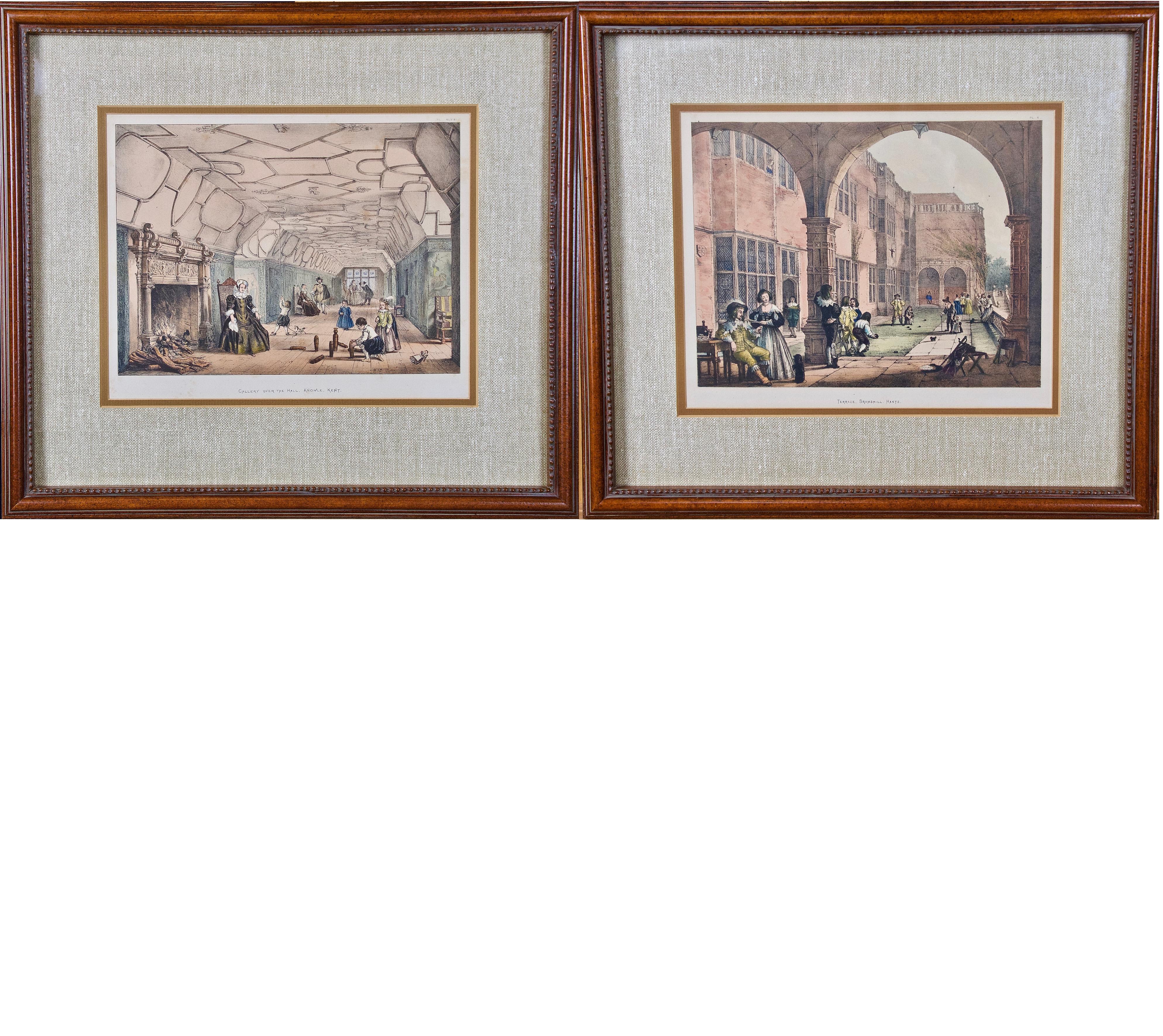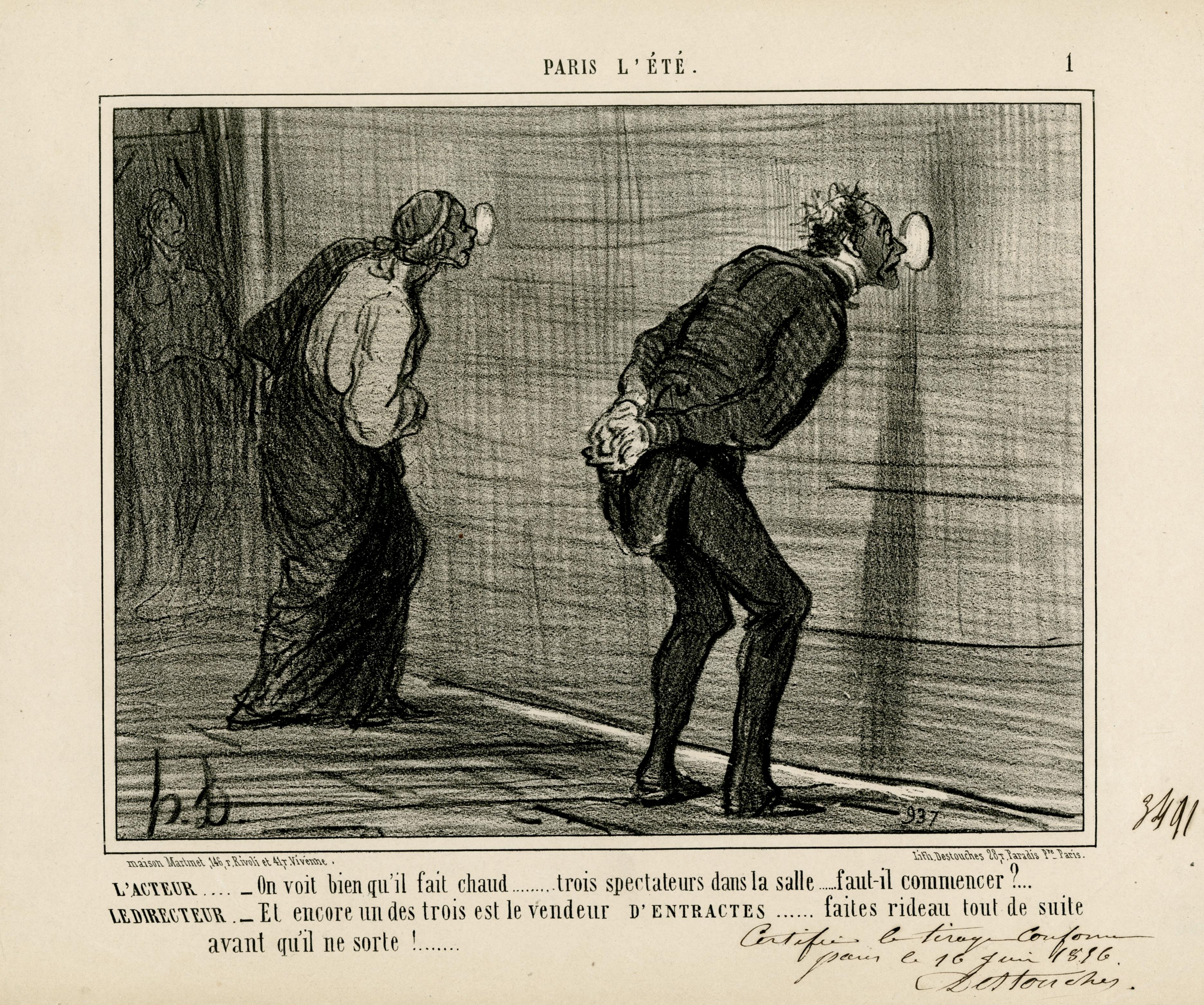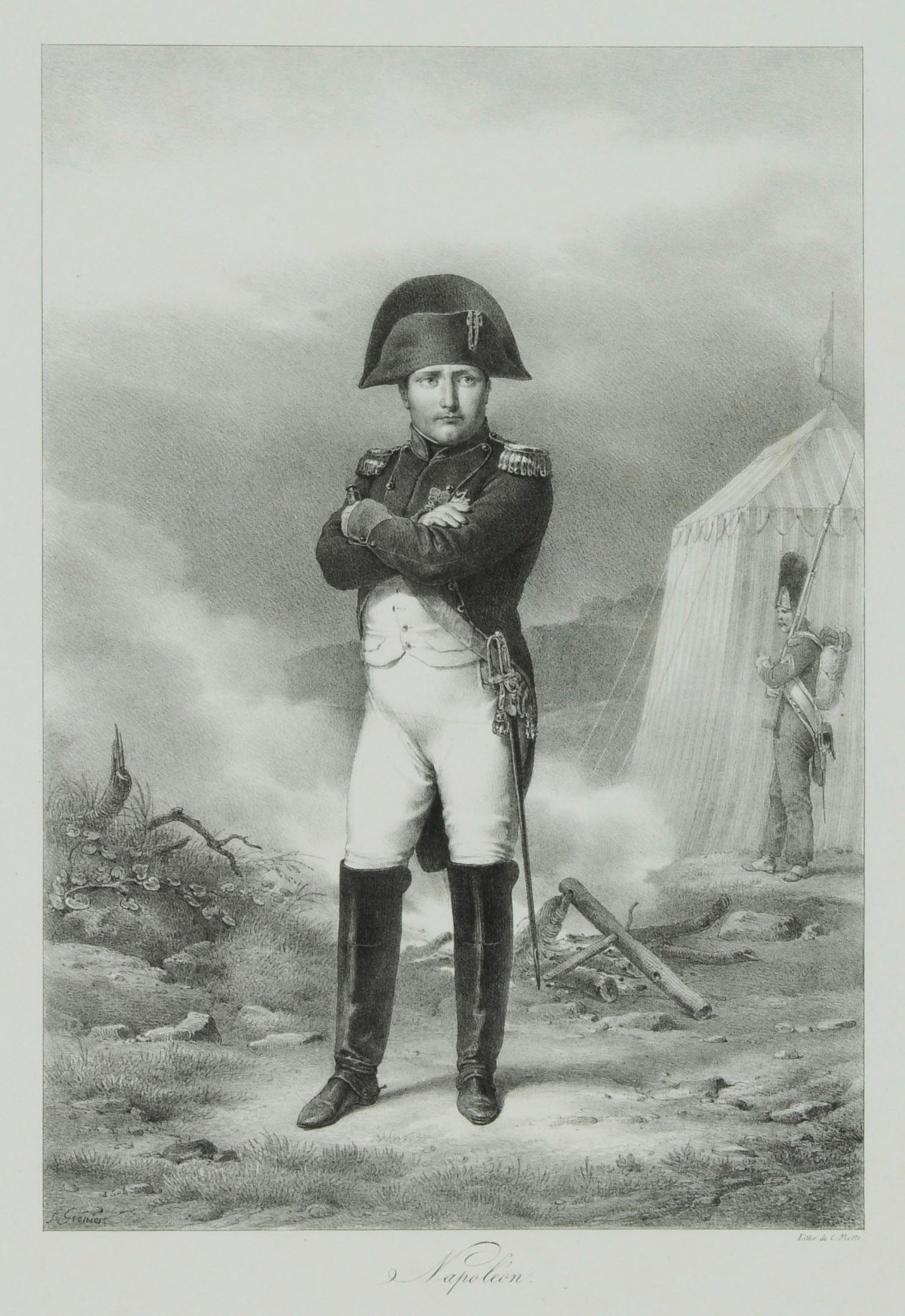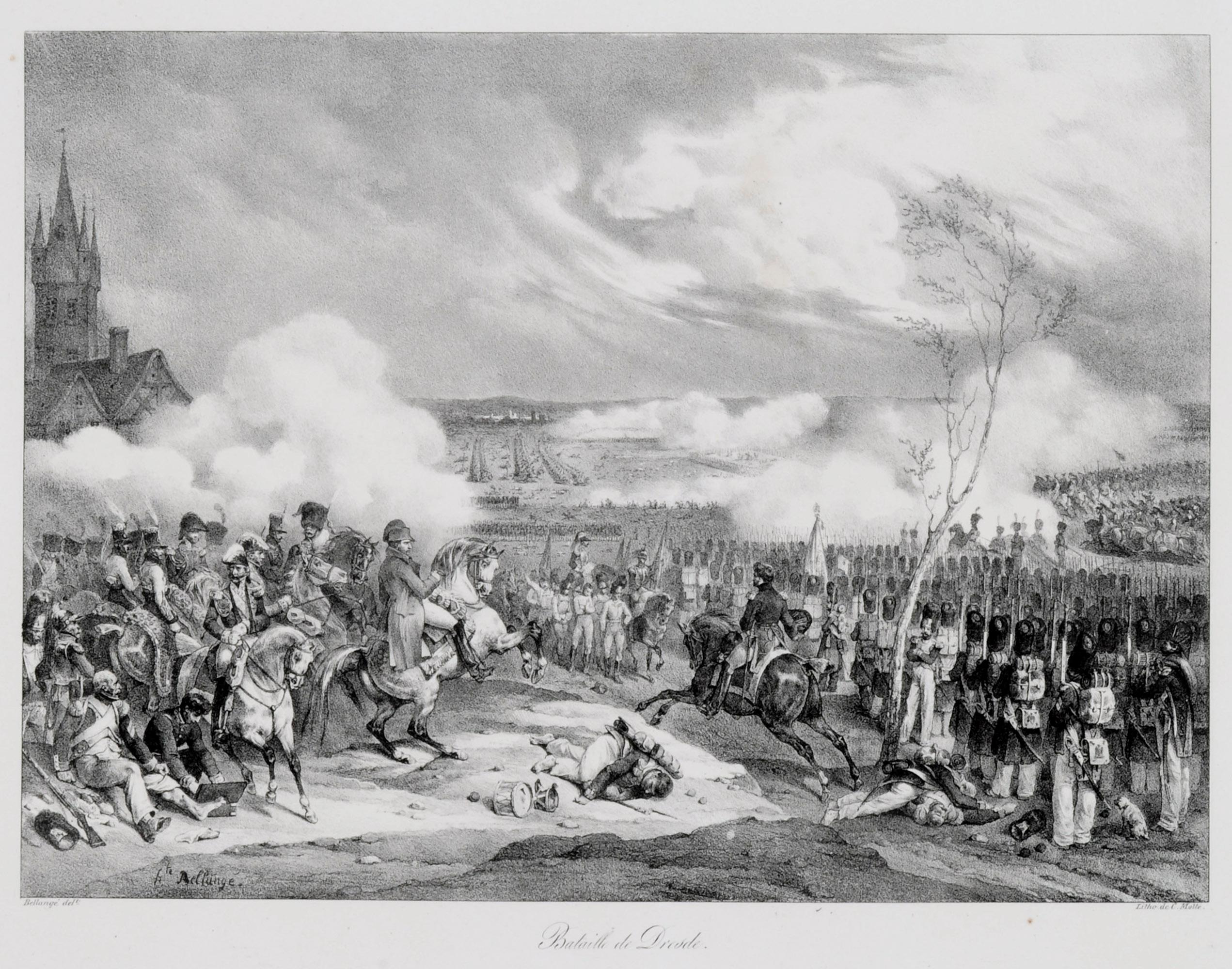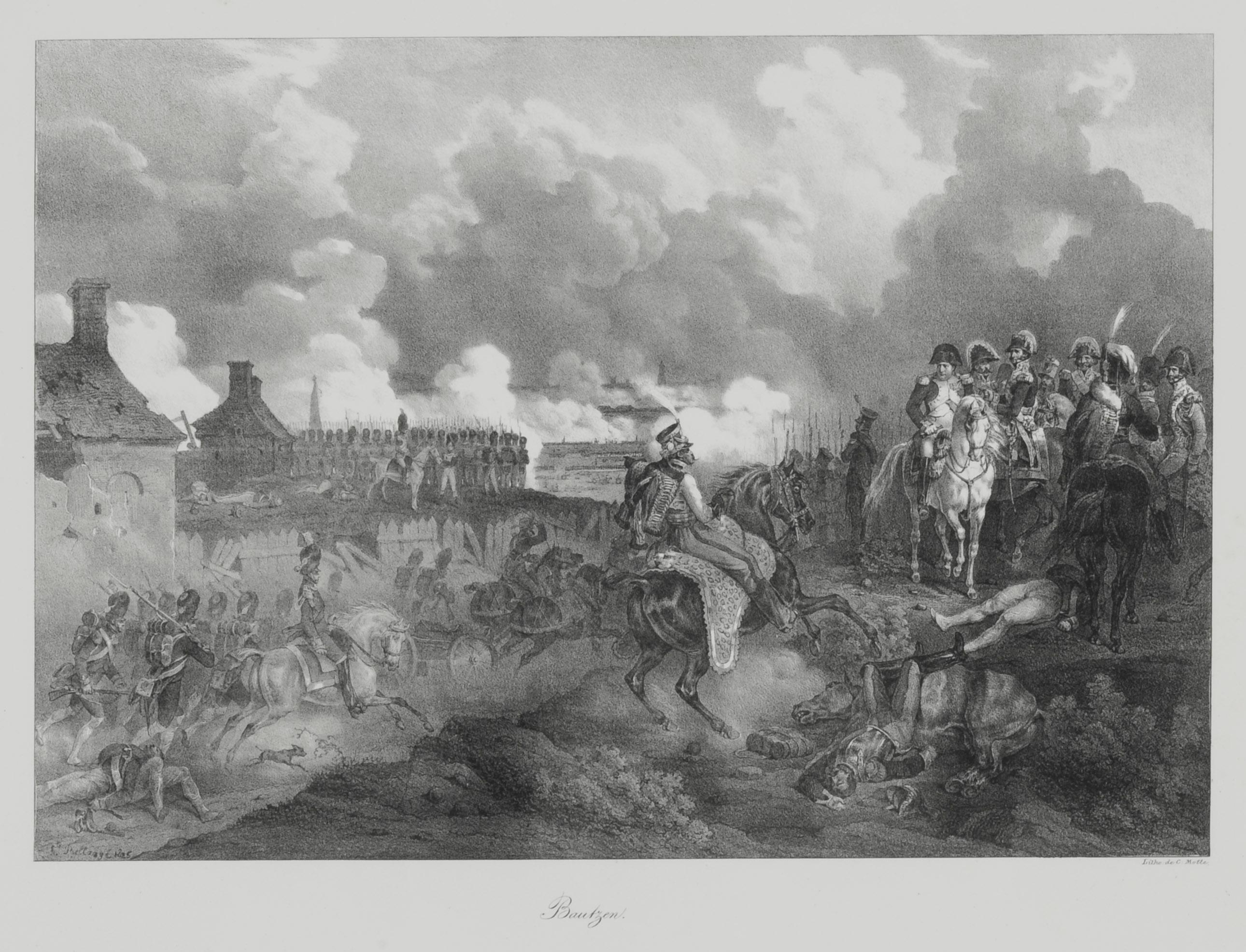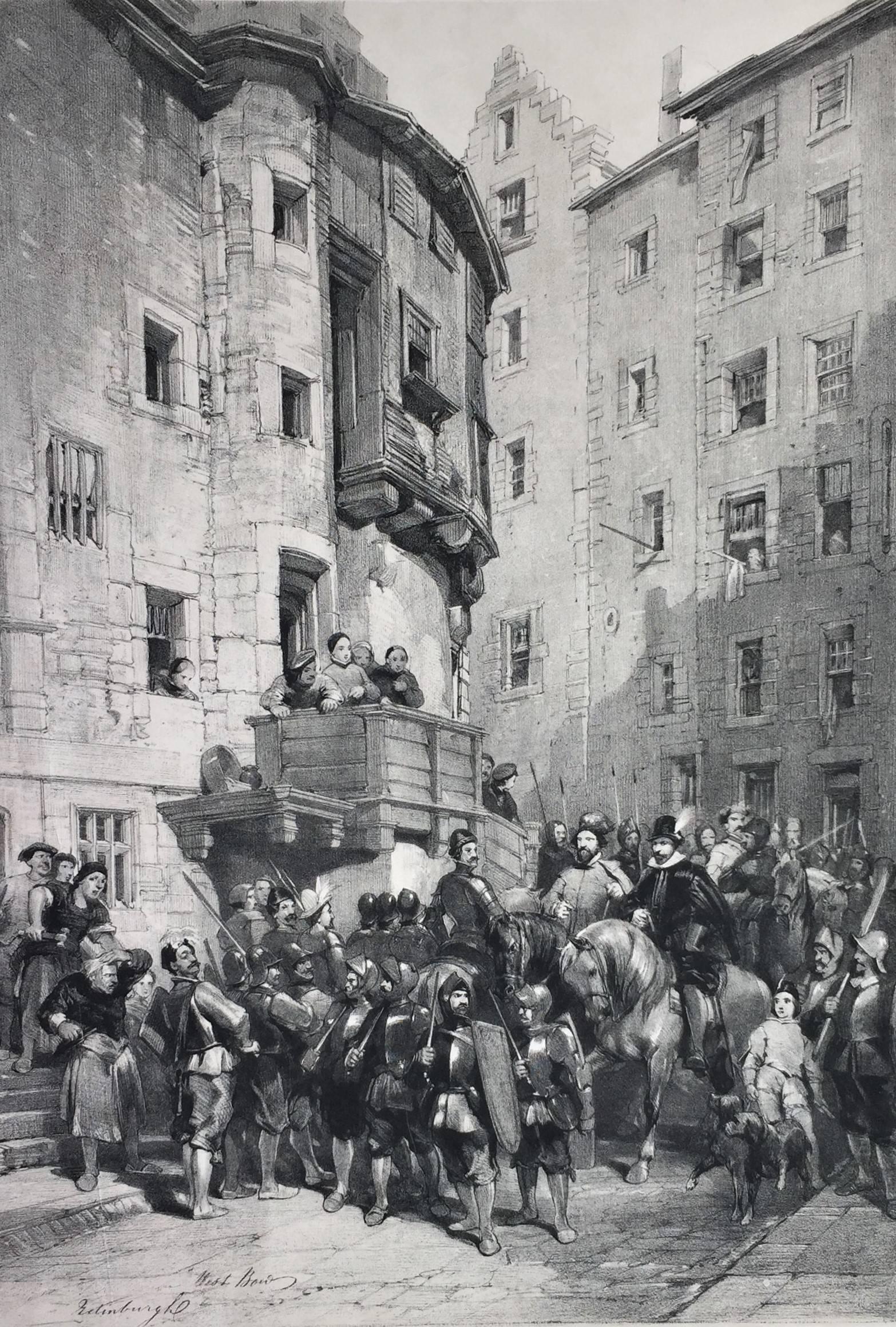Items Similar to Passage du Mont Saint-Bernard
Want more images or videos?
Request additional images or videos from the seller
1 of 11
Jean Louis Andre Theodore GericaultPassage du Mont Saint-Bernard1822
1822
About the Item
Theodore Gericault (1791-1824)
Passage du Mont Saint-Bernard
Lithograph, 1822
Signed and titled in the stone
As published in Arnault "Vie politique et militaire de Napoleon"
Condition: Excellent, aging as expected
Image size: 14 x 161 1/4 inches
Sheet size: 18 7/8 x 24 3/8 inches
Reference: Delteil 44 iv/IV, published state
Théodore Géricault
French painter
Born: September 26, 1791 Rouen France
Died: January 26, 1824 (aged 32) Paris France
Notable Works: “The Charging Chasseur” “The Raft of the Medusa”
Movement / Style: Romanticism
Théodore Géricault, in full Jean-Louis-André-Théodore Géricault, (born September 26, 1791, Rouen, France—died January 26, 1824, Paris), painter who exerted a seminal influence on the development of Romantic art in France. Géricault was a dandy and an avid horseman whose dramatic paintings reflect his flamboyant and passionate personality.
As a student, Géricault learned the traditions of English sporting art from the French painter Carle Vernet, and he developed a remarkable facility for capturing animal movement. He also mastered classicist figure construction and composition under the academician Pierre-Narcissse, Baron Guérin. Another student of Guérin, Eugène Delacroix, was profoundly influenced by Géricault, finding in his example a major point of departure for his own art.
As demonstrated by his earliest major work, The Charging Chasseur (1812), which depicts an officer astride a rearing horse on a smoky battlefield, Géricault was drawn to the colourist style of the Baroque painter Peter Paul Rubens and to the use of contemporary subject matter in the manner of an older colleague, the painter Antoine-Jean Gros. At the Salon of 1814, Géricault’s Wounded Cuirassier shocked critics with its mournful subject and sombre colours. While in Florence and Rome (1816–17), he became fascinated with Michelangelo and Baroque art. His chief project at this time was Race of the Riderless Horse, a heroic frieze composition (never completed) depicting a dangerous race that was an annual event.
After returning to France, Géricault drew a group of lithographs on military subjects that are considered among the earliest masterworks in that medium. Géricault’s masterpiece is the large painting entitled The Raft of the Medusa (c. 1819). This work depicts the aftermath of a contemporary French shipwreck, whose survivors embarked on a raft and were decimated by starvation before being rescued at sea. The shipwreck had scandalous political implications at home—the incompetent captain, who had gained the position because of connections to the Bourbon Restoration government, fought to save himself and senior officers while leaving the lower ranks to die—and so Géricault’s picture of the raft and its inhabitants was greeted with hostility by the government. The work’s macabre realism, its treatment of the raft incident as epic-heroic tragedy, and the virtuosity of its drawing and tonalities combine to give the painting great dignity and carry it far beyond mere contemporary reportage. The portrayal of the dead and dying, developed within a dramatic, carefully constructed composition, addressed a contemporary subject with remarkable and unprecedented passion.
Disappointed by the reception of The Raft of the Medusa, Géricault took the painting to England in 1820, where it was received as a sensational success. He remained there for two years, enjoying the equine culture and producing a body of lithographs, watercolours, and oils of jockeys and horses. Upon his return to France, his friendship with Étienne Georget, a pioneer in psychiatric studies, inspired his series of portraits of victims of insanity, each of whom was seen as a “type” of affliction, including Kleptomania and Delusion of Military Command. Repeated riding accidents and chronic tubercular infections ruined his health, and he died after a long period of suffering.
This article was most recently revised and updated by Amy Tikkanen.
Rich impression
- Creator:Jean Louis Andre Theodore Gericault (1791 - 1824, French)
- Creation Year:1822
- Dimensions:Height: 14 in (35.56 cm)Width: 16.25 in (41.28 cm)
- Medium:
- Movement & Style:
- Period:
- Condition:
- Gallery Location:Fairlawn, OH
- Reference Number:
About the Seller
5.0
Recognized Seller
These prestigious sellers are industry leaders and represent the highest echelon for item quality and design.
Platinum Seller
These expertly vetted sellers are 1stDibs' most experienced sellers and are rated highest by our customers.
Established in 1978
1stDibs seller since 2013
711 sales on 1stDibs
Typical response time: 1 hour
Associations
International Fine Print Dealers Association
- ShippingRetrieving quote...Ships From: Akron, OH
- Return PolicyA return for this item may be initiated within 10 days of delivery.
More From This SellerView All
- L'ACTEUR . . . . - On voit bien qu'il fait chaud . . . . . . . trois spectateursBy Honoré DaumierLocated in Fairlawn, OHL'ACTEUR . . . . - On voit bien qu'il fait chaud . . . . . . . trois spectateurs dans la salle ..... faut-il commencer ? . . . . LE DIRECTEUR .- Et encore un des trois est le vendeu...Category
1850s Romantic Figurative Prints
MaterialsLithograph
- Napoleon StandingLocated in Fairlawn, OHNapoleon Standing Lithograph, 1822 Signed in the stone lower left corner of image (see photo) From: Arnault, A. V. Vie Politique et Militaire de Napoleon (120 plates) Published, Paris, Librairie Historiquem 1822 Printed by C. Motte, Paris Considered to be the major pictorial treatise on Napoleon and his military conquests. Image size: 14 x 9 3/4 inches Sheet size: 23 5/8 x 17 3/4 inches Condition: Very good Horizontal prints...Category
1820s Romantic Figurative Prints
MaterialsLithograph
- Napoleon a BautzenBy Hippolyte BellangéLocated in Fairlawn, OHNapoleon a Bautzen Lithograph, 1822 Signed in the stone (see photo) From: Arnault, A. V. Vie Politique et Militaire de Napoleon (120 plates) Published, Paris, Librairie Historiquem 1...Category
1820s Romantic Figurative Prints
MaterialsLithograph
- Napoleon a Batille de DresdeBy Hippolyte BellangéLocated in Fairlawn, OHBatille de Dresde Lithograph, 1822 From: Arnault, A. V. Vie Politique et Militaire de Napoleon (120 plates) Published, Paris, Librairie Historiquem 1822 Printed by C. Motte, Paris Co...Category
1820s Romantic Figurative Prints
MaterialsLithograph
- A Cart RaceBy Thomas RowlandsonLocated in Fairlawn, OHA Cart Race Hand colored etching & aquatint, 1788 Signed in the plate (see photo) Published by William Hollande, London Inscribed in the plate with title, artist's name and publication line 'Rowlandson. 1788./ London. Pubd 1789 by Wm Holland No 50. Oxford Street.' Reference: M.Dorothy George, 'Catalogue of Political and Personal Satires in the British Museum', VI, 1938) British Museum Satires 7607 Grego, 'Rowlandson', i. 260, Grego II.392 Provenance: Chris Beetles Ltd., London (label), 2003 Jeffrey M. Kaplan, Washington, D.C. (label) Condition: Excellent Archival framing by Chris Beetles Ltd., London Note: The British Museum has two impressions, one trimmed the other full sheet as this example. Accession Number: 1868,0711.35 The Metropolitan Museum has an impression: Accession number 59.533.314 Fitzwilliam Museum: Accession number: 34.14-286 Cleveland Museum of Art accession number: 1958.10 Image description per BM: Three ramshackle two-wheeled carts drawn by wretched horses race (right to left) against a background formed by the church... Note: The British Museum has two impressions, one trimmed the other full sheet as this example. Accession Number: 1868,0711.35 The Metropolitan Museum has an impression: Accession number 59.533.314 Fitzwilliam Museum: Accession number: 34.14-286 Cleveland Museum of Art accession number: 1958.10 Image description per BM: Three ramshackle two-wheeled carts drawn by wretched horses race (right to left) against a background formed by the clouds of dust which they have raised, with a row of gabled houses (right) inscribed 'St Giles', terminating in a church spire (left), and probably representing Broad St. Giles. The occupants of the carts are Irish costermongers typical of St. Giles. The foremost horse gallops, urged on by the shouts of a standing man brandishing a club. The other occupants, two women and a man, cheer derisively the next cart, whose horse has fallen, one woman falling from it head-first, another lies on the ground. The driver lashes the horse furiously. The third cart, of heavier construction, is starting. The horses are partly obscured by the clouds of dust, but denizens watch from casement windows and a door. Two ragged urchins (right) cheer the race; a dog barks. "It was said that the amount of copper Thomas Rowlandson etched would sheathe the British Navy. An inveterate gambler, for much of his life Rowlandson had to produce a flood of his comic prints to stay ahead of financial losses.A wealthy uncle and aunt raised Rowlandson after his textile-merchant father went bankrupt. His career developed quickly. He entered London's Royal Academy Schools in 1772, visited Paris in 1774, exhibited at the Royal Academy in 1775, and won a silver medal in 1777. He left school in 1778 to set up in business. Rowlandson's depictions of life in Georgian England exposed human foibles and vanity with sympathy and rollicking humor. During the 1780s he consolidated the delicate style he used for his coarse subjects. He worked mainly in ink and watercolor, his rhythmic compositions, flowing line, and relaxed elegance inspired by French Rococo art...Category
1780s Romantic Figurative Prints
MaterialsAquatint
- Phrosine and MélidoreLocated in Fairlawn, OHPhrosine and Mélidore Etching, 1879 Signed in the polate lower left of image This etching is after the Dantan painting, a copy after the Pierre-Paul Prud’hom painting Published by Vve. A. Cadart, 56, Bard. Haussman, Paris A deluxe impression with masked letters The Prud’hom painting is in the Musée des Beaux-AÉdouard Joseph Dantan was born on 26 August 1848 in Paris. His grandfather, who had fought in the Napoleonic Wars, was a wood sculptor. His father, Antoine Laurent Dantan, and uncle, Jean-Pierre Dantan, were both well-known sculptors.[1] Dantan was a pupil of Isidore Pils and Henri Lehmann at the École nationale supérieure des Beaux-Arts in Paris.[2] At the age of nineteen he won a commission for a large mural painting of The Holy Trinity for the Hospice Brezin at Marne (Seine-et-Oise).[3] Dantan's first exhibit at the Paris Salon was An Episode in the Destruction of Pompeii in 1869. In 1870 the Franco-Prussian War interrupted his work, and he enlisted in the defence force.[4] He was given the rank of a sergeant, and was later promoted to lieutenant.[5] During the war the family home was burned down.[4] In the years after the war Dantan exhibited a number of other paintings at the Salon including Hercules at the Feet of Omphale (1874), Death of Tusaphane (1875), The Nymph Salmacis (1876), Priam Demanding of Achillees the Body of Hector (1877), Calling of the Apostles Peter and Andrew (1878), Corner of a Studio (1880) and The Breakfast of the Model (1881).[3] He continued to exhibit at the Salon until 1895. In 1890, 1894 and 1895 he served on the jury of the Salon. For twelve years Dantan's companion was the model Agostina Segatori, who had also posed for artists such as Jean-Baptiste Corot, Jean-Léon Gérôme, Eugène Delacroix and Édouard Manet. She bore a child to Dantan, Jean-Pierre, in 1873. On their separation, Agostina opened Café du Tambourin on the Boulevard de Clichy that became a meeting place for artists.[6][fn 1] Dantan spent his summers in Villerville, where he died on 9 July 1897 when the carriage in which he was riding crashed violently into the village church.[8] Style and reception Coin d'atelier (1880) At the 1870 exposition of the Ecole Nationale des Beaux-Arts Dantan received an honorable mention for his submission for the prix de Rome.[9] In 1874 he won a third class medal for his painting of a monk carving a Christ in wood...Category
1870s Romantic Figurative Prints
MaterialsEtching
You May Also Like
- A Pair of Framed 19th Century Colored Lithographs of Tudor Scenes by Joseph NashBy Joseph NashLocated in Alamo, CAThis is a pair of framed 19th century tinted lithographs with hand-coloring entitled "Gallery Over the Hall, Knowle, Kent" and "Terrace Bramshill, Hants" by Charles Joseph Hullmandel (1789-1850) after drawings by Joseph Nash (1809-1878), from "Mansions of England in the Olden Time", published in London in 1839-1849. Nash's publication consists of a series of views of Tudor domestic architecture, which Nash said depicted "the most characteristic features of the domestic architecture of the Tudor Age, and also illustrating the costumes, habits, and recreations of our ancestors." The scenes of the aristocratic ladies and gentlemen (including Henry VIII and Queen Elizabeth I), who are depicted inhabiting the rooms of these great houses, were taken directly from the portraits on the walls. Charles Joseph Hullmandel, was involved in the creation of these lithographs. He was a famous British lithographer, who invented the "lithotint" process, which he named and patented in 1840. This technique, allowing for greater nuance and value gradation than pure lithography, was an ideal means of expression for Nash's historically rich and picturesque depictions of Tudor mansions and their inhabitants. Hullmandel is also remembered for creating many lithographs from the paintings by J. M. W. Turner. The "Gallery Over the Hall" depicts a great hall with children playing with skittles (wooden pins resembling bowling pins), a doll and what looks to be a St Charles spaniel, while a lady in Tudor attire watches over them next to a massive stone fireplace. Adults are watching from in the distance while a man bows...Category
Late 19th Century Romantic Interior Prints
MaterialsLithograph
- West Bow, EdinburghBy George CattermoleLocated in Storrs, CTWest Bow, Edinburgh. c. 1847. Lithograph by Harding after a drawing by Cattermole. 16 3/4 x 11 9/16 (sheet 21 1/2 x 14). From the portfolio "Scotland Delineated in a Series of Views," originally produced for John Parker Lawson and published by E. Gambart in London and Edinburgh, 1849 - 1854. Lithographed by Day and Son. The popular series went through several printings. This is probably from the first edition, volume 1. Scattered foxing, unobtrusive vertical paper fold along the left-hand side. A good impression printed on heavy off-white wove paper Signed in pencil by Cattermole. Housed in a 22 x 20-inch archival mat, suitable for framing. Cattermole was born at Dickleburgh, near Diss, Norfolk. At the age of fourteen he began working as an architectural and topographical draughtsman for the antiquary John Britton...Category
Mid-19th Century Romantic Figurative Prints
MaterialsLithograph
- 'Autumn', Hand-colored Lithograph, listening to music under the treeLocated in Santa Cruz, CAAn early twentieth-century, hand-colored lithograph showing an idyllic scene of two young lovers in medieval dress seated in a rural bower beneath fruit...Category
1920s Romantic Animal Prints
MaterialsPaper, Lithograph
- 'May Morning' from 'American Country Life' lithograph, N. Currier and F. PalmerBy Nathaniel CurrierLocated in Milwaukee, WIThe present print is one of several examples produced for Nathaniel Currier by his longtime collaborator Frances F. "Fanny" Palmer. Harry T. Peters wrote of her: "There is no more interesting and appealing character among the group of artists who worked for Currier & Ives than Fanny Palmer. In an age when women, well-bred women in particular, did not generally work for a living Fanny Palmer for years did exacting, full-time work in order to support a large and dependent family ... Her work ... had great charm, homeliness, and a conscientious attention to detail." One of a series of four prints showing American country life in different seasons, the image presents the viewer with a picturesque view of a successful American farm. In the foreground, a gentleman rides a horse with a young boy before a respectable Italianate country house. Two women and a young girl pick flowers in the garden and several farm workers attend to their duties. Beyond are other homes and a city on the coast. 16.63 x 23.75 inches, artwork 28.13 x 33.38 inches, frame Entitled bottom center "American Country Life - May Morning" Signed in the stone, lower left "F.F. Palmer, Del." Signed in the stone, lower right "Lith. by N. Currier" Copyrighted lower center "Entered according to Act of Congress in the year 1855 by N. Currier in the Clerk's office of the Southern District of N.Y." Inscribed bottom center "New York, Published by N. Currier 152 Nassau Street" Framed to conservation standards using silk-lined 100 percent rag matting and Museum Glass with a gold gilded liner, all housed in a stained wood moulding. Nathaniel Currier was a tall introspective man with a melancholy nature. He could captivate people with his piercing stare or charm them with his sparkling blue eyes. Nathaniel was born in Roxbury, Massachusetts on March 27th, 1813, the second of four children. His parents, Nathaniel and Hannah Currier, were distant cousins who lived a humble yet spartan life. When Nathaniel was eight years old, tragedy struck. Nathaniel’s father unexpectedly passed away leaving Nathaniel and his eleven-year-old brother Lorenzo to provide for the family. In addition to their mother, Nathaniel and Lorenzo had to care for six-year-old sister Elizabeth and two-year-old brother Charles. Nathaniel worked a series of odd jobs to support the family, and at fifteen, he started what would become a life-long career when he apprenticed in the Boston lithography shop of William and John Pendleton. A Bavarian gentleman named Alois Senefelder invented lithography just 30 years prior to young Nat Currier’s apprenticeship. While under the employ of the brothers Pendleton, Nat was taught the art of lithography by the firm’s chief printer, a French national named Dubois, who brought the lithography trade to America. Lithography involves grinding a piece of limestone flat and smooth then drawing in mirror image on the stone with a special grease pencil. After the image is completed, the stone is etched with a solution of aqua fortis leaving the greased areas in slight relief. Water is then used to wet the stone and greased-ink is rolled onto the raised areas. Since grease and water do not mix, the greased-ink is repelled by the moisture on the stone and clings to the original grease pencil lines. The stone is then placed in a press and used as a printing block to impart black on white images to paper. In 1833, now twenty-years old and an accomplished lithographer, Nat Currier left Boston and moved to Philadelphia to do contract work for M.E.D. Brown, a noted engraver and printer. With the promise of good money, Currier hired on to help Brown prepare lithographic stones of scientific images for the American Journal of Sciences and Arts. When Nat completed the contract work in 1834, he traveled to New York City to work once again for his mentor John Pendleton, who was now operating his own shop located at 137 Broadway. Soon after the reunion, Pendleton expressed an interest in returning to Boston and offered to sell his print shop to Currier. Young Nat did not have the financial resources to buy the shop, but being the resourceful type he found another local printer by the name of Stodart. Together they bought Pendleton’s business. The firm ‘Currier & Stodart’ specialized in "job" printing. They produced many different types of printed items, most notably music manuscripts for local publishers. By 1835, Stodart was frustrated that the business was not making enough money and he ended the partnership, taking his investment with him. With little more than some lithographic stones, and a talent for his trade, twenty-two year old Nat Currier set up shop in a temporary office at 1 Wall Street in New York City. He named his new enterprise ‘N. Currier, Lithographer’ Nathaniel continued as a job printer and duplicated everything from music sheets to architectural plans. He experimented with portraits, disaster scenes and memorial prints, and any thing that he could sell to the public from tables in front of his shop. During 1835 he produced a disaster print Ruins of the Planter's Hotel, New Orleans, which fell at two O’clock on the Morning of the 15th of May 1835, burying 50 persons, 40 of whom Escaped with their Lives. The public had a thirst for newsworthy events, and newspapers of the day did not include pictures. By producing this print, Nat gave the public a new way to “see” the news. The print sold reasonably well, an important fact that was not lost on Currier. Nat met and married Eliza Farnsworth in 1840. He also produced a print that same year titled Awful Conflagration of the Steamboat Lexington in Long Island Sound on Monday Evening, January 18, 1840, by which melancholy occurrence over One Hundred Persons Perished. This print sold out very quickly, and Currier was approached by an enterprising publication who contracted him to print a single sheet addition of their paper, the New York Sun. This single page paper is presumed to be the first illustrated newspaper ever published. The success of the Lexington print launched his career nationally and put him in a position to finally lift his family up. In 1841, Nat and Eliza had their first child, a son they named Edward West Currier. That same year Nat hired his twenty-one year old brother Charles and taught him the lithography trade, he also hired his artistically inclined brother Lorenzo to travel out west and make sketches of the new frontier as material for future prints. Charles worked for the firm on and off over the years, and invented a new type of lithographic crayon which he patented and named the Crayola. Lorenzo continued selling sketches to Nat for the next few years. In 1843, Nat and Eliza had a daughter, Eliza West Currier, but tragedy struck in early 1847 when their young daughter died from a prolonged illness. Nat and Eliza were grief stricken, and Eliza, driven by despair, gave up on life and passed away just four months after her daughter’s death. The subject of Nat Currier’s artwork changed following the death of his wife and daughter, and he produced many memorial prints and sentimental prints during the late 1840s. The memorial prints generally depicted grief stricken families posed by gravestones (the stones were left blank so the purchasers could fill in the names of the dearly departed). The sentimental prints usually depicted idealized portraits of women and children, titled with popular Christian names of the day. Late in 1847, Nat Currier married Lura Ormsbee, a friend of the family. Lura was a self-sufficient woman, and she immediately set out to help Nat raise six-year-old Edward and get their house in order. In 1849, Lura delivered a son, Walter Black Currier, but fate dealt them a blow when young Walter died one year later. While Nat and Lura were grieving the loss of their new son, word came from San Francisco that Nat’s brother Lorenzo had also passed away from a brief illness. Nat sank deeper into his natural quiet melancholy. Friends stopped by to console the couple, and Lura began to set an extra place at their table for these unexpected guests. She continued this tradition throughout their lives. In 1852, Charles introduced a friend, James Merritt Ives, to Nat and suggested he hire him as a bookkeeper. Jim Ives was a native New Yorker born in 1824 and raised on the grounds of Bellevue Hospital where his father was employed as superintendent. Jim was a self-trained artist and professional bookkeeper. He was also a plump and jovial man, presenting the exact opposite image of his new boss. Jim Ives met Charles Currier through Caroline Clark, the object of Jim’s affection. Caroline’s sister Elizabeth was married to Charles, and Caroline was a close friend of the Currier family. Jim eventually proposed marriage to Caroline and solicited an introduction to Nat Currier, through Charles, in hopes of securing a more stable income to support his future wife. Ives quickly set out to improve and modernize his new employer’s bookkeeping methods. He reorganized the firm’s sizable inventory, and used his artistic skills to streamline the firm’s production methods. By 1857, Nathaniel had become so dependent on Jims’ skills and initiative that he offered him a full partnership in the firm and appointed him general manager. The two men chose the name ‘Currier & Ives’ for the new partnership, and became close friends. Currier & Ives produced their prints in a building at 33 Spruce Street where they occupied the third, fourth and fifth floors. The third floor was devoted to the hand operated printing presses that were built by Nat's cousin, Cyrus Currier, at his shop Cyrus Currier & Sons in Newark, NJ. The fourth floor found the artists, lithographers and the stone grinders at work. The fifth floor housed the coloring department, and was one of the earliest production lines in the country. The colorists were generally immigrant girls, mostly German, who came to America with some formal artistic training. Each colorist was responsible for adding a single color to a print. As a colorist finished applying their color, the print was passed down the line to the next colorist to add their color. The colorists worked from a master print displayed above their table, which showed where the proper colors were to be placed. At the end of the table was a touch up artist who checked the prints for quality, touching-in areas that may have been missed as it passed down the line. During the Civil War, demand for prints became so great that coloring stencils were developed to speed up production. Although most Currier & Ives prints were colored in house, some were sent out to contract artists. The rate Currier & Ives paid these artists for coloring work was one dollar per one hundred small folios (a penny a print) and one dollar per one dozen large folios. Currier & Ives also offered uncolored prints to dealers, with instructions (included on the price list) on how to 'prepare the prints for coloring.' In addition, schools could order uncolored prints from the firm’s catalogue to use in their painting classes. Nathaniel Currier and James Merritt Ives attracted a wide circle of friends during their years in business. Some of their more famous acquaintances included Horace Greeley, Phineas T. Barnum, and the outspoken abolitionists Rev. Henry Ward, and John Greenleaf Whittier (the latter being a cousin of Mr. Currier). Nat Currier and Jim Ives described their business as "Publishers of Cheap and Popular Pictures" and produced many categories of prints. These included Disaster Scenes, Sentimental Images, Sports, Humor, Hunting Scenes, Politics, Religion, City and Rural Scenes, Trains, Ships, Fire Fighters, Famous Race Horses, Historical Portraits, and just about any other topic that satisfied the general public's taste. In all, the firm produced in excess of 7500 different titles, totaling over one million prints produced from 1835 to 1907. Nat Currier retired in 1880, and signed over his share of the firm to his son Edward. Nat died eight years later at his summer home 'Lion’s Gate' in Amesbury, Massachusetts. Jim Ives remained active in the firm until his death in 1895, when his share of the firm passed to his eldest son, Chauncey. In 1902, faced will failing health from the ravages of Tuberculosis, Edward Currier sold his share of the firm to Chauncey Ives...Category
Mid-19th Century Romantic Figurative Prints
MaterialsWatercolor, Lithograph
- 'Victor's Camp - Hell Gate Ronde' original John Mix Stanley lithographBy John Mix StanleyLocated in Milwaukee, WIIn the mid-nineteenth century, the United States government set out to survey and document its newly acquired lands and territories west of the Mississippi. The goals of these surveys were manifold: to produce topographical maps, to document flora and fauna, and to document natural resources to build the emerging US economy. These surveys, and the images from them, also functioned to build the new sense of American identity with the landscape, condensing vistas into the 'picturesque' tradition of European image making. Thus, the entire span of US territory could be seen as a single, cohesive whole. This lithograph comes from one of six surveys commissioned by the Army's Topographic Bureau in 1853, which sought to find the best route to construct a transcontinental railroad. The result was a thirteen-volume report including maps, lithographs, and technical data entitled 'Explorations and Surveys to ascertain the most practicable and economical route for a Railroad from the Mississippi river to the Pacific Ocean.' In particular, the print comes from the northern survey, commanded by Isaac Stevens, which explored the regions between the 47th and 49th parallels. Stanley shows here the stop the Stanley Party made at the junction of the Bitterroot and Hell Gate, in present day Montana. While there, the Party met with the Flathead Chief by the name Victor, as is shown in the image. The figures and their encampment are dwarfed by the vast landscape around them, indicating the sublimity of these new American territories. 5.75 x 8.75 inches, image 6.5 x 9.25 inches, stone 17 x 20 inches, frame Artist 'Stanley Del.' lower left Entitled 'Victor's Camp - Hell Gate Ronde' lower center margin Publisher 'Sarony, Major & Knapp. Lith.s 449 Broadway N.Y.' lower right Inscribed 'U.S.P.R.R. EXP. & SURVEYS — 47th & 49th PARALLELS' upper left Inscribed 'GENERAL REPORT — PLATE XXXI' upper right Framed to conservation standards using 100 percent rag matting with French accents; glazed with UV5 Plexiglas to inhibit fading; housed in a gold reverse ogee moulding. Print in overall good condition; some localized foxing and discoloration; minor surface abrasions to frame. John Mix Stanley...Category
1850s Romantic Landscape Prints
MaterialsLithograph
- 'Distribution of Goods to the Assiniboines' original John Mix Stanley lithographBy John Mix StanleyLocated in Milwaukee, WIIn the mid-nineteenth century, the United States government set out to survey and document its newly acquired lands and territories west of the Mississippi. The goals of these surveys were manifold: to produce topographical maps, to document flora and fauna, and to document natural resources to build the emerging US economy. These surveys, and the images from them, also functioned to build the new sense of American identity with the landscape, condensing vistas into the 'picturesque' tradition of European image making. Thus, the entire span of US territory could be seen as a single, cohesive whole. This lithograph comes from one of six surveys commissioned by the Army's Topographic Bureau in 1853, which sought to find the best route to construct a transcontinental railroad. The result was a thirteen-volume report including maps, lithographs, and technical data entitled 'Explorations and Surveys to ascertain the most practicable and economical route for a Railroad from the Mississippi river to the Pacific Ocean.' When it came to depicting the Assiniboine people, as seen in the present print, Stanley chose to juxtapose their encampment, marked by tipis in the distance, with the encampment of the Isaac Stevens survey party. In the foreground, commemorating this moment, Isaac Stevens can be seen presenting trade goods, which are known to include thirty two dressed skins and two robes. The survey leader Isaac Stevens noted being grateful for the generosity of the Assiniboine, commenting: "I felt very grateful indeed to those Indians, for their kindness to my men, their proffer of kind feeling and hospitality to myself and the survey." This description and this image, however, are arguably depicted through rose-colored glasses: to the Assiniboine people, this meeting may well have included stressful diplomatic relationships and have indicated a threat to the sovereignty over the territories agreed to be theirs by the 1851 Treaty of Fort Laramie. 5.75 x 8.75 inches, image 6.5 x 9.25 inches, stone 17 x 19.75 inches, frame Artist 'Stanley Del.' lower left Entitled 'Distribution of Goods to the Assiniboines' lower center margin Publisher 'Sarony, Major & Knapp. Lith.s 449 Broadway N.Y.' lower right Inscribed 'U.S.P.R.R. EXP. & SURVEYS — 47th & 49th PARALLELS' upper left Inscribed 'GENERAL REPORT — PLATE XIV' upper right Framed to conservation standards using 100 percent rag matting with French accents; glazed with UV5 Plexiglas to inhibit fading; housed in a gold reverse ogee moulding. Print in overall good condition; some localized foxing and discoloration; frame in excellent condition. John Mix Stanley...Category
1850s Romantic Landscape Prints
MaterialsLithograph
Recently Viewed
View AllMore Ways To Browse
Picture Guerin
3 Horseman Art
4 Horseman
Nixon Poster
Stephen Wilkes
Vuitton Fusion
De Poilly
Louis Vuitton Panda
Reginald Marsh Coney Island
Stanislao Lepri
Vintage Crawling Baby
Vuitton Panda
Alex Katz Pas De Deux
Chikanobu Woodblock Print
David Hockney Chair
Hockney Chair
Louis Vuitton Murakami Panda
Manet Aquatint
